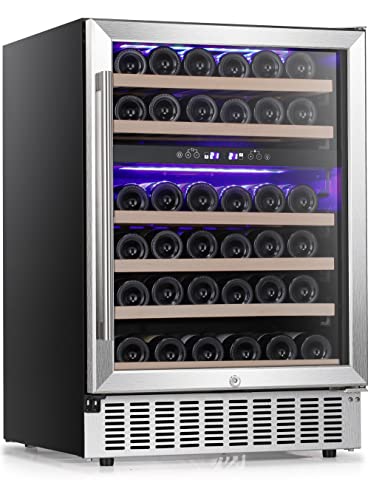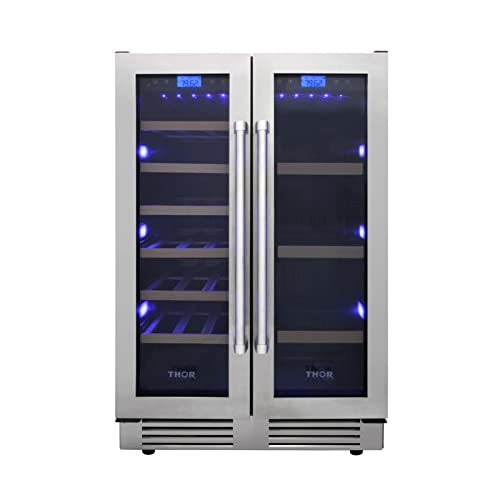In this step-by-step guide, we will show you how to compare different models and features of built-in wine fridge cabinets. If you’re a wine enthusiast or someone who loves to entertain, having a built-in wine fridge cabinet can be a great addition to your home. This guide will help you understand the key factors to consider when comparing different models and features, such as size, capacity, temperature control, design, and energy efficiency. By following our simple steps, you’ll be able to make an informed decision and find the perfect built-in wine fridge cabinet that suits your needs and preferences.
Keep Your Wine Collection Perfectly Chilled
Step 1: Research different models
In this step, we will research and gather information on different models of built-in wine fridge cabinets. To start, we recommend utilizing online resources such as consumer review websites, manufacturer websites, and online retailers. These platforms will provide a wealth of information about various brands, sizes, and designs available in the market.
Begin by searching for reputable brands that specialize in wine fridges, as they often offer a wider range of options and tend to have better customer reviews. Take note of the size requirements you have for your built-in wine fridge cabinet, as this will help narrow down your choices. Additionally, consider the design features that are important to you, such as the number of temperature zones, shelving options, and door styles.
Once you have a list of potential models, read through customer reviews and ratings to get an idea of the overall satisfaction levels and performance of each model. Pay attention to any recurring issues or concerns mentioned by customers. This research will help you make an informed decision about which model will best suit your needs and preferences. By thoroughly researching and gathering information on different models, you can ensure that you choose a built-in wine fridge cabinet that perfectly complements your wine collection and enhances your overall wine storage experience.
Step 2: Understand your requirements
Once you have a list of potential models, let’s dive into understanding your specific requirements. First, consider the capacity needed for your purposes. Think about the quantity of items you need to store or display and ensure that the model you choose can accommodate them comfortably. Next, contemplate the importance of temperature control. Depending on what you plan to store, you may require precise temperature settings to maintain freshness or to meet specific storage requirements. Make sure the models you’re considering have the necessary temperature control capabilities.
Moving on, take a moment to think about shelving options. Consider how you want to organize your items and whether adjustable or removable shelves would be beneficial. This will allow you to customize the interior space according to your needs. Lastly, don’t forget to consider any additional features that are important to you. This could include factors such as energy efficiency, lighting options, and ease of maintenance. By taking all of these requirements into account, you’ll be well-equipped to make an informed decision when choosing the right model for your needs.
Step 3: Compare features
Now that we know our requirements, let’s dive into comparing the features of the different models. Start by looking for features that align with our needs, such as dual temperature zones, UV protection, humidity control, noise level, and energy efficiency. These features will play a crucial role in determining which model suits us best.
To compare the features effectively, we recommend using bullet points to break up the information. This will make it easier to read and understand. Begin by listing the models you are considering, and then provide a brief overview of the key features for each model. For example:
- Model A:
- Dual temperature zones: Allows us to store red and white wines at different temperatures.
- UV protection: Protects our wines from harmful UV rays that can damage the quality.
- Humidity control: Maintains the ideal humidity level to prevent corks from drying out.
- Noise level: Operates quietly, ensuring minimal disruption in our living space.
- Energy efficiency: Designed to consume less energy, leading to lower electricity bills.
Repeat this format for each model, highlighting the specific features that differentiate them. By organizing the information in this way, we can easily compare the features of each model and make an informed decision based on our needs and preferences.
Step 4: Assess build quality and warranty
In this step, we will focus on assessing the build quality of the wine fridge cabinets. Start by examining the materials used to construct the cabinets. Look for options made from durable materials such as stainless steel or solid wood, as they offer excellent longevity and resistance to wear and tear. These materials also provide proper insulation, ensuring that your wine stays at the ideal temperature.
Next, inspect the craftsmanship of the cabinets. Check for sturdy construction, paying attention to details like the joints and hinges. Look for well-constructed cabinets that are free from any signs of poor workmanship or flimsy parts. Cabinets with solid construction will not only protect your wine but also stand the test of time.
Moving on, it’s essential to consider the warranty offered by the manufacturer. Check the terms and conditions to ensure you have sufficient coverage. Look for warranties that offer comprehensive protection against defects in materials or workmanship, as well as coverage for any potential damage that may occur during shipping. A longer warranty period is often an indicator of the manufacturer’s confidence in the product’s quality.
For example, a wine fridge cabinet made from stainless steel with seamless joints and a 5-year warranty would be a strong option to consider. On the other hand, a cabinet made from thin plastic with visible seams and a limited 1-year warranty might raise concerns about its durability and longevity.
By carefully assessing the build quality of the wine fridge cabinets and checking the warranty, you can ensure that you invest in a high-quality product that will provide reliable performance and protection for your wine collection.
Step 5: Read reviews and consider budget
To make an informed decision, we highly recommend reading reviews from other customers who have purchased the models you are considering. This step will provide valuable insights into the performance and reliability of the cabinets. Look for reviews that specifically address the features and functionalities you are interested in. Pay attention to any recurring issues or concerns that customers mention. This will help you gauge the overall satisfaction of previous buyers and make a more informed choice.
After reading reviews, it’s time to consider your budget and choose a model that offers the best value for your money. Assess your financial constraints and determine how much you are willing to spend on the cabinets. Keep in mind that higher price doesn’t always guarantee better quality. Look for a balance between price and features, ensuring that the chosen model meets your requirements without breaking the bank. Consider any additional costs such as installation or maintenance when calculating the overall budget. By carefully evaluating both reviews and your budget, you’ll be equipped to make a well-informed decision on which cabinets to purchase.
Making an informed decision
In conclusion, we have explored the various aspects to consider when comparing different models and features of built-in wine fridge cabinets. We started by discussing the importance of size and capacity, highlighting the need to choose a fridge that fits your specific wine collection. We then delved into temperature control options, emphasizing the significance of dual-zone capabilities for storing different types of wine. Additionally, we discussed the importance of insulation and UV protection to ensure the optimal storage conditions for your precious bottles. Finally, we explored the convenience features such as shelving, lighting, and noise levels, which can greatly enhance your overall experience. By considering these factors, you will be equipped to make an informed decision and find the perfect built-in wine fridge cabinet that suits your needs and preferences. Cheers to perfectly chilled wines!
Choosing the Perfect Fit
Tips for Selecting the Perfect Wine Cooler
Getting the Most out of Your Built-in Wine Fridge Cabinet
- Determine the ideal temperature: Before placing your wine bottles in the fridge cabinet, it’s important to set the temperature to the appropriate level. Typically, the recommended temperature for storing wine is between 45 to 55°F (7 to 13°C). Adjust the temperature accordingly using the controls provided on the fridge cabinet
- Organize your bottles: Once the temperature is set, it’s time to organize your wine bottles. Consider grouping them by type, such as red, white, or sparkling. You can also arrange them by region or personal preference. This will make it easier to locate and select the bottle you want when the time comes
- Store bottles properly: When placing the bottles inside the fridge cabinet, ensure that they are positioned horizontally. This allows the wine to be in contact with the cork, helping to prevent it from drying out. Keeping the bottles horizontal also helps with stability and prevents them from rolling around
- Avoid excessive vibrations: Vibrations can disturb the sediment in the wine, affecting its taste and quality. To minimize vibrations, make sure to place the wine fridge cabinet in a stable and level location. Avoid placing it near appliances or areas with heavy foot traffic
- Regularly clean and maintain: To keep your built-in wine fridge cabinet in optimal condition, it’s important to clean it regularly. Follow the manufacturer’s instructions on how to properly clean and maintain the cabinet. This may include wiping down the interior, cleaning the shelves, and occasionally checking the seals on the door to ensure they are airtight
- Remember, these are just some basic guidelines to help you get started with using a built-in wine fridge cabinet. It’s always a good idea to refer to the specific instructions and recommendations provided by the manufacturer for your particular model. Enjoy your wine!

















